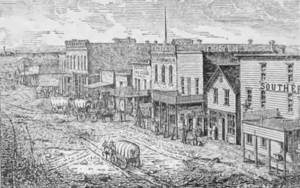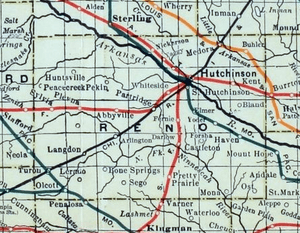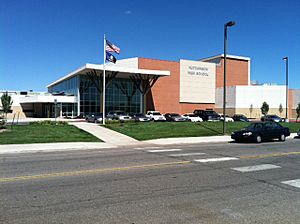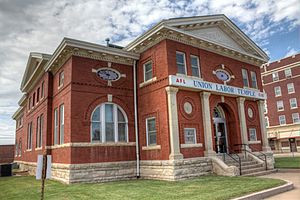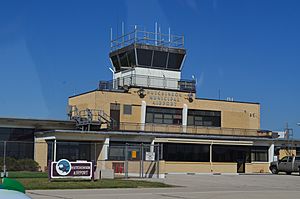Hutchinson, Kansas facts for kids
Quick facts for kids
Hutchinson, Kansas
|
|||
|---|---|---|---|
|
City and County seat
|
|||
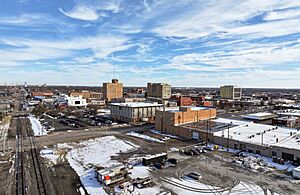
Skyline (2023)
|
|||
|
|||
| Nickname(s):
The Salt City, Hutch
|
|||
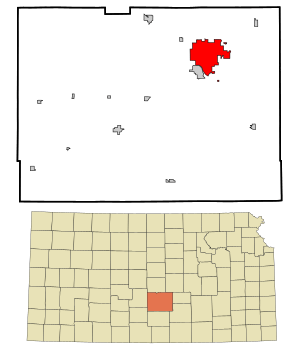
Location within Reno County and Kansas
|
|||
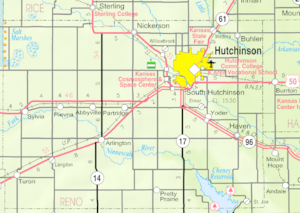
|
|||
| Country | United States | ||
| State | Kansas | ||
| County | Reno | ||
| Founded | 1871 | ||
| Incorporated | 1872 | ||
| Named for | C.C. Hutchinson | ||
| Area | |||
| • Total | 24.63 sq mi (63.80 km2) | ||
| • Land | 24.58 sq mi (63.66 km2) | ||
| • Water | 0.05 sq mi (0.14 km2) | ||
| Elevation | 1,526 ft (465 m) | ||
| Population
(2020)
|
|||
| • Total | 40,006 | ||
| • Density | 1,624.3/sq mi (627.05/km2) | ||
| Time zone | UTC-6 (CST) | ||
| • Summer (DST) | UTC-5 (CDT) | ||
| ZIP code |
67501-67502
|
||
| Area code | 620 | ||
| FIPS code | 20-33625 | ||
| GNIS ID | 485597 | ||
Hutchinson is a city in Kansas, United States. It is the largest city in Reno County and its main town. The city is located on the Arkansas River.
Hutchinson has been home to salt mines since 1887. This is why it is nicknamed "Salt City." Locals often call it "Hutch." In 2020, about 40,000 people lived here.
Each year, Hutchinson hosts the Kansas State Fair. It also holds the National Junior College Athletic Association (NJCAA) Men's Basketball Tournament. The city is home to Hutchinson Community College, the Cosmosphere aerospace museum, and Strataca, an underground salt museum.
History of Hutchinson
The city of Hutchinson was started in 1871. A frontiersman named Clinton "C.C." Hutchinson made a deal with the Santa Fe Railway. He wanted to build a town where the railroad crossed the Arkansas River. The town actually grew a bit north, by Cow Creek.
C.C. Hutchinson also started the Reno County Bank in 1873. By 1878, he built the state's first water mill in Hutchinson. The community was called "Temperance City" for a while. This was because its founder did not allow the sale of alcohol. Hutchinson officially became a city in August 1872.
Railroads and Salt Discovery
In 1887, the Chicago, Kansas and Nebraska Railway built a main railroad line through Hutchinson. This line later became part of the Union Pacific Railroad. Many locals still call it the "Rock Island" railroad.
Also in 1887, large salt deposits were found. This happened when Ben Blanchard was drilling for oil. Salt mining quickly became a major industry in Hutchinson. This is how the city got its famous nickname, "Salt City."
Kansas State Fair and Modern Events
Hutchinson had been holding county fairs since 1873. By 1900, people started calling it the Kansas State Fair. In 1913, Hutchinson gave land to the State of Kansas for the fairgrounds. The official Kansas State Fair has been held in Hutchinson ever since.
During World War II in 1943, German and Italian prisoners of war helped with labor shortages in Kansas. A smaller prisoner-of-war camp was set up in Hutchinson.
On January 17, 2001, a large amount of natural gas leaked from an underground storage field nearby. It caused about 15 gas blowholes to appear. An explosion in the downtown area destroyed two businesses. Another explosion the next day killed two people. The Kansas National Guard helped people leave parts of the city. Specialists checked the city for more leaks.
Since 2013, the mayor of Hutchinson has declared the city's name changed to "Smallville" for one day each June. This is to honor Superman's fictional Kansas hometown. It happens during the Smallville Con, a comic-book convention.
Geography and Climate
Hutchinson is in south-central Kansas. It is located where U.S. Route 50 and Kansas Highway 96 (K-96) meet. The city is about 39 miles (63 km) northwest of Wichita.
The city sits on the northeast bank of the Arkansas River. Cow Creek, which flows into the Arkansas River, also runs through the city. The total area of Hutchinson is about 22.75 square miles (58.92 km2). Most of this is land.
Hutchinson's Weather
Hutchinson has a humid subtropical climate. This means it has hot, humid summers and cold, dry winters. Temperatures often go above 90°F (32°C) in the summer. They drop below 32°F (0°C) in the winter. Snowfall averages about 6.9 inches (17.5 cm) per year. The city gets about 32.93 inches (836 mm) of rain each year.
The warmest month is usually July. January is typically the coolest month. May is often the wettest month. The highest temperature ever recorded was 113°F (45°C) on July 27, 2011. The lowest was -19°F (-28°C) on February 16, 2021.
| Climate data for Hutchinson, Kansas (Hutchinson Municipal Airport (Kansas)), 1991–2020 normals, extremes 1948–present | |||||||||||||
|---|---|---|---|---|---|---|---|---|---|---|---|---|---|
| Month | Jan | Feb | Mar | Apr | May | Jun | Jul | Aug | Sep | Oct | Nov | Dec | Year |
| Record high °F (°C) | 77 (25) |
86 (30) |
91 (33) |
98 (37) |
102 (39) |
109 (43) |
113 (45) |
112 (44) |
107 (42) |
97 (36) |
88 (31) |
82 (28) |
113 (45) |
| Mean maximum °F (°C) | 67.7 (19.8) |
71.7 (22.1) |
81.3 (27.4) |
88.2 (31.2) |
94.2 (34.6) |
99.6 (37.6) |
104.1 (40.1) |
103.0 (39.4) |
98.0 (36.7) |
88.6 (31.4) |
76.9 (24.9) |
65.7 (18.7) |
105.5 (40.8) |
| Mean daily maximum °F (°C) | 45.1 (7.3) |
49.9 (9.9) |
60.1 (15.6) |
69.8 (21.0) |
78.6 (25.9) |
89.0 (31.7) |
93.6 (34.2) |
91.8 (33.2) |
84.2 (29.0) |
72.3 (22.4) |
58.4 (14.7) |
46.5 (8.1) |
69.9 (21.1) |
| Daily mean °F (°C) | 32.1 (0.1) |
36.3 (2.4) |
45.9 (7.7) |
55.5 (13.1) |
65.7 (18.7) |
76.0 (24.4) |
80.7 (27.1) |
78.7 (25.9) |
70.7 (21.5) |
58.1 (14.5) |
44.9 (7.2) |
34.5 (1.4) |
56.6 (13.7) |
| Mean daily minimum °F (°C) | 19.2 (−7.1) |
22.6 (−5.2) |
31.6 (−0.2) |
41.2 (5.1) |
52.8 (11.6) |
62.9 (17.2) |
67.7 (19.8) |
65.6 (18.7) |
57.3 (14.1) |
44.0 (6.7) |
31.3 (−0.4) |
22.5 (−5.3) |
43.2 (6.3) |
| Mean minimum °F (°C) | 0.9 (−17.3) |
4.0 (−15.6) |
13.1 (−10.5) |
24.7 (−4.1) |
36.3 (2.4) |
49.5 (9.7) |
56.5 (13.6) |
53.8 (12.1) |
40.4 (4.7) |
25.5 (−3.6) |
13.4 (−10.3) |
4.2 (−15.4) |
−4.4 (−20.2) |
| Record low °F (°C) | −14 (−26) |
−19 (−28) |
−9 (−23) |
15 (−9) |
28 (−2) |
39 (4) |
48 (9) |
47 (8) |
31 (−1) |
13 (−11) |
2 (−17) |
−13 (−25) |
−19 (−28) |
| Average precipitation inches (mm) | 0.84 (21) |
1.25 (32) |
2.34 (59) |
2.65 (67) |
5.52 (140) |
4.46 (113) |
4.03 (102) |
4.11 (104) |
2.39 (61) |
2.50 (64) |
1.46 (37) |
1.38 (35) |
32.93 (835) |
| Average snowfall inches (cm) | 1.4 (3.6) |
2.4 (6.1) |
0.9 (2.3) |
0.3 (0.76) |
0.0 (0.0) |
0.0 (0.0) |
0.0 (0.0) |
0.0 (0.0) |
0.0 (0.0) |
0.1 (0.25) |
0.6 (1.5) |
1.2 (3.0) |
6.9 (17.51) |
| Average precipitation days (≥ 0.01 in) | 4.5 | 5.2 | 6.9 | 9.0 | 9.6 | 8.5 | 7.9 | 8.2 | 6.9 | 6.9 | 4.6 | 4.2 | 82.4 |
| Average snowy days (≥ 0.1 in) | 1.6 | 1.7 | 0.7 | 0.6 | 0.0 | 0.0 | 0.0 | 0.0 | 0.0 | 0.1 | 0.6 | 1.3 | 6.6 |
| Source 1: NOAA | |||||||||||||
| Source 2: National Weather Service | |||||||||||||
Population of Hutchinson
| Historical population | |||
|---|---|---|---|
| Census | Pop. | %± | |
| 1880 | 1,540 | — | |
| 1890 | 8,682 | 463.8% | |
| 1900 | 9,379 | 8.0% | |
| 1910 | 16,364 | 74.5% | |
| 1920 | 23,298 | 42.4% | |
| 1930 | 27,085 | 16.3% | |
| 1940 | 30,013 | 10.8% | |
| 1950 | 33,575 | 11.9% | |
| 1960 | 37,574 | 11.9% | |
| 1970 | 36,885 | −1.8% | |
| 1980 | 40,284 | 9.2% | |
| 1990 | 39,308 | −2.4% | |
| 2000 | 40,787 | 3.8% | |
| 2010 | 42,080 | 3.2% | |
| 2020 | 40,006 | −4.9% | |
| U.S. Decennial Census 2010-2020 |
|||
In 2020, Hutchinson had a population of 40,006 people. There were about 16,535 households. Most residents were white, but the city is also home to African American, Native American, and Asian people. About 13% of the population was Hispanic or Latino.
The average age in Hutchinson was about 39.8 years old. About 21% of the people were under 18.
Hutchinson's Economy
Salt was found in Reno County in 1887. This led to the first salt-processing plants west of the Mississippi River. At first, salt was taken out by pumping water into salt wells. In 1923, the Carey Salt Company opened the only salt mine in Hutchinson. This mine is still used today by Hutchinson Salt Company. Other companies like Cargill and Morton Salt also have salt plants here.
Some parts of the salt mine are used to store important things. These include movie and TV masters, data tapes, and business records. For example, the original masters for The Wizard of Oz and Star Wars are kept here.
The world's longest grain elevator was built in Hutchinson in 1961.
Dillon's grocery stores started in Hutchinson in the 1920s. Dillon's later joined with The Kroger Co. in 1983. The company still has a distribution center and offices for Dillons and Kwik Shop in town.
The Eaton Corporation has a plant in Hutchinson that makes hydraulics parts. Collins Bus Corporation, which makes small school buses, is also located near Hutchinson. StraightLine HDD makes tools for directional drilling here.
In 2009, Siemens announced it would open a factory in Hutchinson. This factory builds parts for wind turbines. It was expected to create 400 jobs. Kuhn-Krause also has a large factory in Hutchinson. They make equipment for farming.
Education in Hutchinson
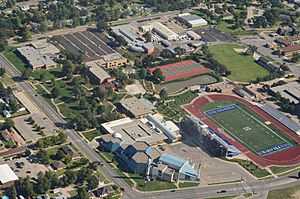
Colleges and Universities
The main campus of Hutchinson Community College is in the city. It is a two-year public college.
Schools for Kids
Three public school districts serve students in and around Hutchinson. These are USD 308, USD 309, and USD 313.
Hutchinson Public Schools (USD 308)
Hutchinson USD 308 runs twelve schools in the city:
- Avenue A Elementary School (Pre-K-6)
- Faris Elementary School (K-6)
- Graber Elementary School (K-6)
- Lincoln Elementary School (K-6)
- Magnet School at Allen (K-6)
- McCandless Elementary School (K-6)
- Morgan Elementary School (K-6)
- Wiley Elementary School (K-6)
- Hutchinson Middle School 7 (7th grade)
- Hutchinson Middle School 8 (8th grade)
- Hutchinson High School (9-12th grade)
- Hutchinson Career & Technical Educational Academy
The Hutchinson High School football team, called the Salthawks, has had many successful seasons.
Other Public Schools
Buhler USD 313 operates three schools near Hutchinson:
- Union Valley Elementary School (K-5)
- Plum Creek Elementary (K-5)
- Prairie Hills Middle School (6-8)
Nickerson–South Hutchinson USD 309 operates one school near Hutchinson:
- Reno Valley Middle School (7-8).
Private Schools
Hutchinson also has three private schools:
- Central Christian School (K-12)
- Holy Cross Catholic School (Pre-K-6)
- Trinity Catholic High School (7-12)
City Transportation
Several main roads go through Hutchinson. U.S. Route 50 runs south of the city. K-96 goes around the west side. K-61 runs through the eastern part of the city.
Reno County Area Transit (RCAT) provides local public transport bus service. Greyhound Lines offers long-distance bus service. BeeLine Express also provides bus service to nearby cities.
The Hutchinson Municipal Airport is on the east side of the city. It is mainly used for private planes. For commercial flights, people usually use Wichita Dwight D. Eisenhower National Airport in Wichita.
Three railroads serve Hutchinson. The BNSF Railway runs east-west through the city. Amtrak uses this line for passenger trains. Hutchinson is a stop on the Southwest Chief train route. The Union Pacific Railroad also runs through the city. Finally, the Kansas and Oklahoma Railroad has two lines that end in Hutchinson.
Media in Hutchinson
The Hutchinson News is the city's main newspaper. It is published every day.
Hutchinson is also a center for radio and television in south-central Kansas. Many radio stations broadcast from the city. Hutchinson is part of the Wichita-Hutchinson television market. Some TV stations, like CBS (KWCH-DT) and PBS (KPTS), are licensed to Hutchinson but broadcast from Wichita.
Fun Things to Do
Hutchinson is home to the Prairie Dunes Country Club. This golf course is often ranked among the best in the U.S. It has hosted several national golf tournaments. The club was started in the 1930s.
On the northeastern edge of Hutchinson is the Sand Hills State Park. It is a great place to explore nature.
Places to Visit
- Kansas Cosmosphere and Space Center: A museum about space and rockets.
- Strataca: An amazing underground salt museum.
- Kansas State Fair: A big annual fair with rides, food, and shows.
- Carey Park: Home to the Hutchinson Zoo, a golf course, and the Salt City Splash water park.
- Hutchinson Sports Arena: A place for sports events.
- Hobart-Detter Field: A baseball field.
Historic Places
Many buildings in Hutchinson are listed on the National Register of Historic Places. These include:
- Fox Theater
- Terminal Station
- St. Teresa's Catholic Church
Notable People
Many interesting people have come from Hutchinson. You can find a list of them in the main article.
See also
 In Spanish: Hutchinson (Kansas) para niños
In Spanish: Hutchinson (Kansas) para niños



